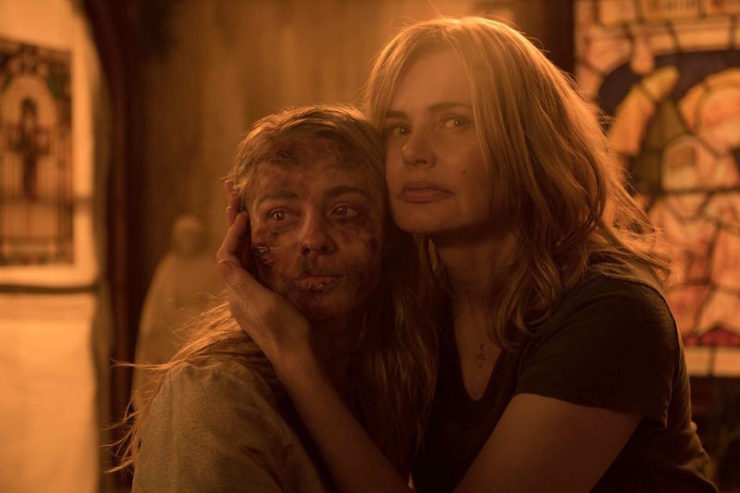Are you watching The Exorcist yet? Because you should be watching The Exorcist. Season One was a surprisingly moving, scary update on the classic horror film, and as of last week’s episode, the show is just about as good this time around. So how did a franchise built on misogyny, kneejerk conservatism, and grotesque violence reinvent itself as one of the most thoughtful, progressive shows I’ve seen?
The latest take on The Exorcist fulfills the promise of the original film, and creates a singular show that treats faith, skepticism, and horror all with equal respect. And the best part? It does so by challenging the original film’s troubling takes on gender and sexuality, and by giving us two very different heroic priests.
Spoilers for the Exorcist films and the entire first season of the television series. I’m also going to throw out a general content warning here: we’re talking about the intersection of religion, gender, and abuse in a lot of cases, and I’ll have to talk about rape a bit, so tread cautiously if you need.
The film series started off with a bang with the original The Exorcist in 1973, breaking box records that were set by The Godfather the summer before, and setting a new bar that wasn’t met until two summers later with Jaws. Financially it was (easily) one of the most successful movies of the 1970s, and, along with Rosemary’s Baby, sparked a trend of religious-themed horror. It’s inspired parodies, references, rip-offs, has been analyzed by film scholars and banned by small towns. All you have to do is look at the contemporary reactions to it to see how it grabbed U.S. culture by the neck and shook:
Thirty years later, when The New York Times reviewed Paul Shrader’s prequel, The Exorcist: Dominion, reviewer Stephen Holden specifically took issue with Shrader’s “perversely high-minded goal of enshrining the remnants of a tacky horror franchise by treating them as sacred relics in a serious metaphysical investigation.” He went on to say:
But there’s no escaping that “Dominion” is finally an act of commercial scavenging. You may retrieve the eggshells, coffee grounds and banana peels from your trash and assemble them into a cute, novelty gift basket. But if you bend down and take a whiff, your nose is still met with the scent of garbage. As any chef will tell you, it’s the ingredients, stupid! Mud cannot be turned into a chocolate soufflé, nor can “The Exorcist,” in its many incarnations, be transformed into anything beyond a lurid supernatural shocker.
Clearly the cultural moment had shifted. It would be fair to think that the film’s themes had faded into irrelevance. But now Jeremy Slater has brought the world of The Exorcist back for a show on Fox, using the show as a way to interrogate the assumptions of the film franchise. This is one of the boldest reinventions of a pop culture icon I’ve ever seen, all while still being a great horror show that deals in existential dread just as well as it does in jump scares and body horror. It’s particularly interesting when looking at the way the show deals with gender and sexuality. In order to look at why the show is so great, I’ll need to hop back a few decades.
The Exorcist (1973)
Mannnn are women ever evil in the Exorcist movies. Or, should I say, adult female sexuality is evil and dangerous to society. Actually, scratch that—any sexuality is dangerous. The ads for The Exorcist, and much of the criticism around it, focus on the idea that it’s about an outside evil attacking purity and innocence, in the form of a demon targeting a young, sweet-natured girl. But when you look at the development of the book and film, it becomes apparent that a deep discomfort with gender and sex were coded into it from the beginning.
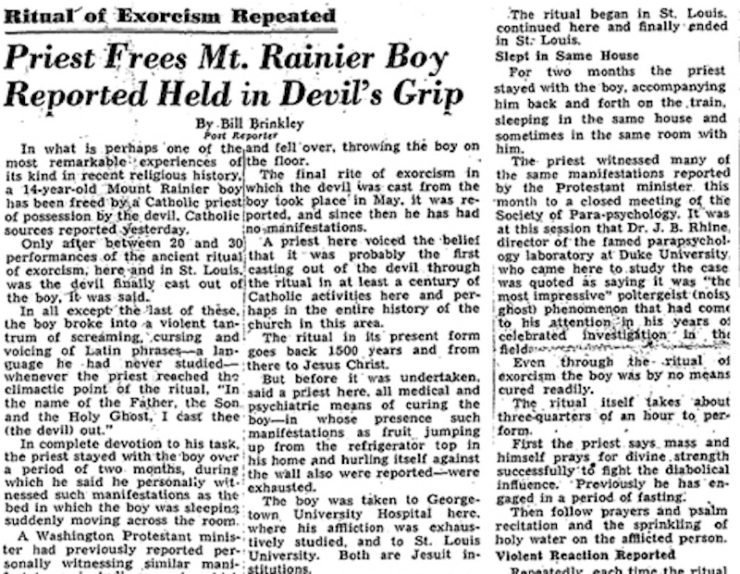
The real-life case William Blatty’s novel (and later the movie) was based on involved a boy, subsequently called “Roland Doe” or “Robbie Manheim” depending on who was recounting the story, who was exorcised in the late 1940s. Roland was the only child of a German Lutheran family, and was especially close to his aunt, who was a practicing spiritualist, and the two would use her Ouija board together. After her death strange things started happening in the boy’s presence, including inexplicable sounds and furniture appearing to move. The family brought their Lutheran pastor into the home, and he advised them to seek a Catholic priest. At this point, there was supposedly an exorcism conducted at Georgetown hospital, and when that didn’t take, Roland was taken to his cousin’s home in St. Louis, where he was attended by three Jesuit priests, who completed the rite. Plenty of people thought the kid was just seeking attention and tricking his family, and every report I’ve read states that he went on to live a normal life.
When Blatty wrote The Exorcist, he based the possession in part on the Doe/Manheim case, but made one giant, notable decision: rather than a boy who battles possession with the help of a churchgoing, nuclear family, we get a girl on the cusp of puberty, living with her newly-single mother, rejected by her father, whose body undergoes a horrifyingly sexualized invasion.
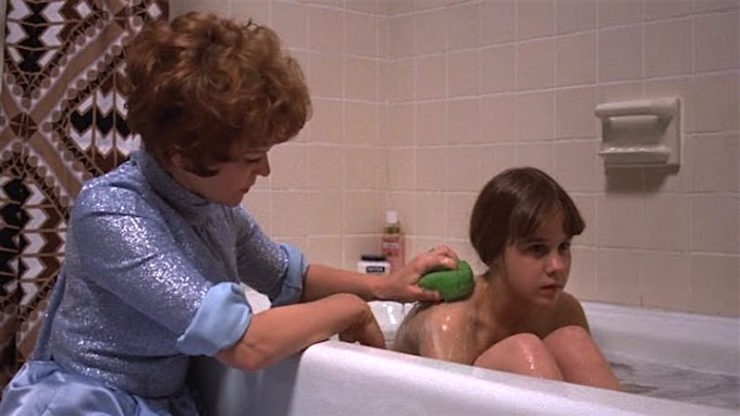
Chris MacNeil is a famous actress, swathed in a sheen of Hollywood glamour and unthinking atheism, and is woefully unequipped for spiritual crisis. She’s raising her daughter Regan alone in a temporary, rented home in Georgetown while she’s on location for a movie. We watch as Regan hides in her room, listening to her mother try repeatedly to get her father on the phone: he’s in Europe with his new girlfriend, and has forgotten his own daughter’s birthday. When Regan begins using a Ouija board it isn’t coded as a relic of a popular religious movement, but as a vaguely occult party game that the lonely, unsupervised daughter found in the basement and used without guidance, thus opening her to attack form evil forces.
The possession itself germinates for weeks before the overworked, stressed-out Chris notices how bad things are. She first seeks a secular solution and takes Regan to a battery of doctors and psychologists. She can’t believe that her baby girl swears like an angry Teamster when the nurses try to collect blood, but this is where the film really turns: while Chris insists that Regan is an innocent girl, her language is immediately sexualized. This isn’t just a kid testing their parent’s boundaries by saying “bastard”, this is a torrent of “fucks” and “cunts” and “cocksuckers.” This is the nightmare outcome of women’s lib: broken homes, uprooted children, mothers trying to do the work of both parents—and failing.
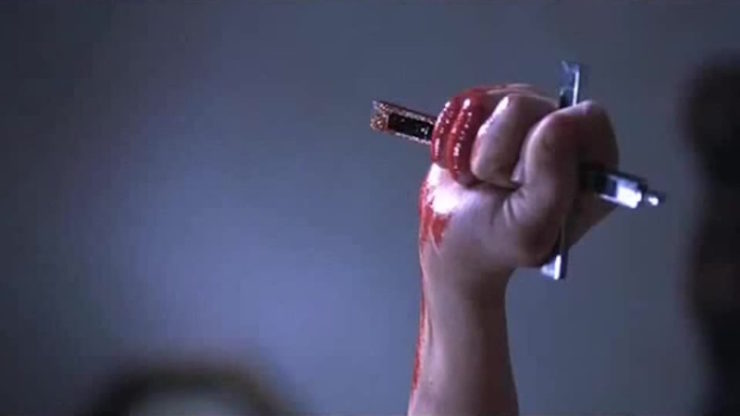
Once the film commits to the narrative of demonic possession it becomes relentlessly sexual. This is, again, a little girl. We don’t even know if she’s had her period yet. But within a few scenes she’s implicated in murder, when Burke Dennings is flung from her bedroom window while babysitting her, and then, well, there’s the “masturbation with the crucifix” scene. Can we look at that for a moment? Every article I’ve read about this movie refers to this as the “masturbation with the crucifix” scene. Even James Baldwin refers to it as “masturbation with a crucifix”. Which it is decidedly not. This is a very young girl who is being raped by a demon—that the demon is using the girl’s hand is irrelevant. When Chris finds Regan she is covered in blood from the waist down, and when you see her actually stab at herself, it’s obvious that she has either cut herself or done this violently enough to break her own hymen.
This is only the movie’s version—in the book it’s even more violent, and Blatty makes a point of saying that Regan has an orgasm from this act…which I feel is unlikely. There would maybe be some muscle spasm happening, but it’s a horrific stretch to use that term. In her own voice, Regan is screaming for help while this is happening—being done to her. Then the demon takes over, she grabs her mother by the shoulders, and forces her mother’s face in between her legs. After it flings Chris to the floor the demon turns Regan’s head 180 degrees, and uses Dennings’ voice to ask: “Do you know what she did? Your cunting daughter?” Even in my varied travels through profanity, I’d never heard the phrase “cunting” before The Exorcist. And you could argue that its because Dennings is British (where that word is used often, mostly directed toward men, and doesn’t get the sort of instant, hissing reaction it tends to in the US), but I still think it’s significant that Friedken and Blatty went with that phrasing rather than the already sexual “fucking” or the more contextually-appropriate “goddamned”.
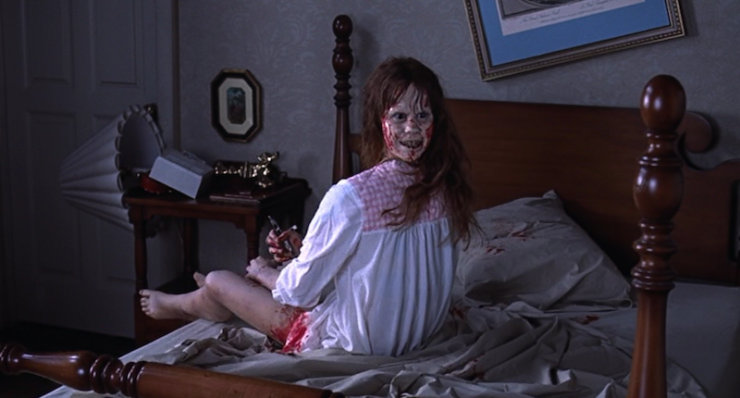
This is all before the exorcism even starts.
Father Dyer recommends his best friend Father Karras, and the parish sends in professional exorcist Father Lankester Merrin. After the two priests converge on the MacNeils things become even more graphic. We have a young girl tied to a bed in an often see-through white nightgown; she screams “Your mother sucks cocks in hell!” and “You want to put a cock in her ass!” as the demon taunts the priests; the demon refers to Regan as “the little piglet” or “the sow”; and Regan is constantly throwing up and salivating. In the book she also has near constant diarrhea and has to wear a diaper. The drama now centers on the priests, and Chris recedes into the background as Merrin becomes the pillar of faith and Karras becomes ever more stricken with doubt. The girl who has been endangered by her mother’s secular, free-thinking lifestyle can only be rescued by these celibate men she’s never met, who care about her only as a lost soul, not as an individual personality. Merrin succumbs to a heart attack, and in the end what saves Regan is Karras’s willing sacrifice. He invites the demon into his own soul with the suggestive phrase “Take me!” and then… things get murky. He leaps out the window and rolls down those infamous stairs just as Burke Dennings did. But did he do that to save Regan, so the demon couldn’t hurt her? Did the demon murder Karras? Was Karras simply using this as an opportunity for his own suicide? Does the demon decide, with these multiple deaths, that he has won? Because theoretically he could just pop back into Regan once Karras was dead, couldn’t he?
These questions are waved away as Father Dyer finds Karras and administers extreme unction. Somehow the body count is dealt with, and Chris and Regan are next seen getting ready to move back to Hollywood, and Father Dyer stops in to say goodbye. Regan has physical scars from her ordeal, but already looks healthy again, and seems like she has gone back to being a carefree young girl. Order has been restored. Right after Chris insists Regan doesn’t remember anything, the girl notices Dyer’s white collar, has a flash of recognition, and kisses him on the cheek. (Whatever she remembers, she has learned to love and respect the office of the priesthood.) The film ends on a hint that Kinderman and Dyer will become friends, but never dips back into Regan’s mindset, or how this may have changed her. We see the torture of Regan’s fragile body, but we are never, in the course of the entire film, in her head.
Exorcist II: The Heretic (1977)
In the sequel, we come a little closer to seeing things from her perspective, but there still needs to be a mediator in the form of a priest. In John Boorman’s Exorcist II: The Heretic, following a whole bunch of fuzzy New Age psychology adventures, Regan once again has to throw herself on the mercy of Catholicism. She meets yet another faith-deficient priest, this time a Father Lamont, who is trying to clear Merrin’s name. For some reason, some church officials are trying to label him a heretic (hence the title) even though he died battling Satan. They inject a few finer points from the philosophy of Teilhard de Chardin to try to add some class to the film, but there’s no getting around the simple fact: this is the movie that made James Earl Jones dress up as a locust.

Regan is seeing a psychologist, played by Louise Fletcher, who runs a terrifying panopticon cum mental hospital, and living with Sharon, her mom’s old assistant. (Her mom is off shooting a movie because Ellen Burstyn refused to do this film.) These two women try to use psychology and the POWER OF LOVE to help her, each to no avail, as the only help can come from a priest. The film takes the time to show us that Louise Fletcher is neglecting her children for her career, and Sharon’s gruesome death is shown in great detail. This leads us into a us into a scene that seems to be an attempt at an exorcism, but which features no religiosity at all… but I’ll get there in a second.
At the end of the film, Regan is literally split in two—the good Regan and the evil, still-Pazuzu-possessed Regan. Good Regan wears lacey Renaissance Festival-looking dresses through out the film (always in white and beige), only allows herself a tiny sheen of lip gloss, and raises doves. And also just… picks up little dove trinkets whenever she sees them:
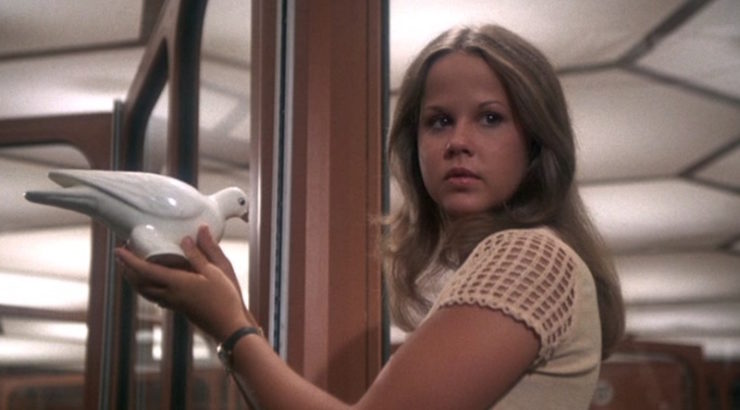
Eeee-villl Regan wears a low cut slutty nightgown, and, heaven protect us, eyeliner:
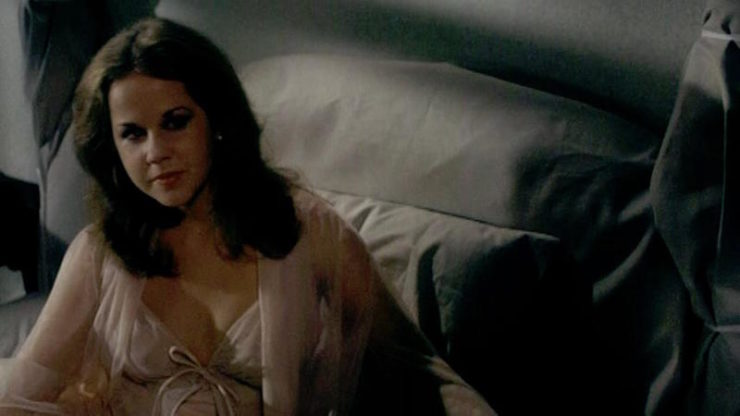
When Father Lamont attempts an exorcism, Evil Regan crushes his mouth to her breasts the same way Possessed Regan pulled her mother’s face into her crotch in the last film, and Lamont makes out with her neck while Good Regan, who over the course of the film has smiled at one (1) boy, once, during play rehearsal, looks on in horror. This film presents the most literal madonna/whore scenario I’ve ever seen. The only way it could be more literal is if they cast actual Madonna, split her into “Lucky Star” and “Justify My Love” era Madonnas, and made them battle each other for the soul of “Like a Prayer” era Madonna.
Boorman spoke repeatedly about wanting to make a film about goodness and hope, and apparently the best way he could find to do this was to show us a good girl and a bad girl duking it out—but again, we don’t really get to know how Regan feel about any of this. She looks upset, but the film is resolutely told from either Lamont’s or Louise Fletcher’s points-of-view. So Boorman, who again wanted to make a positive film about hope, fixed this problem by giving us a lengthy scene where a priest throttles a 16-year-old girl, before punching her repeatedly in the breasts until he breaks through her sternum and pulls her heart out.
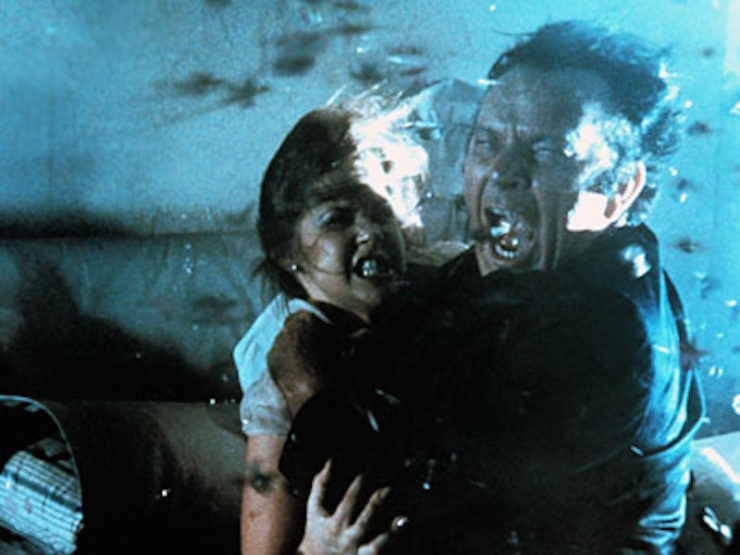
The power of Christ compels you?
Good Regan, seemingly fine with watching a priest punch her doppelganger to death, channels the power of James Earl Jones’ anti-locust magic (I am not kidding) and uses a mystical bullroarer to drive Pazuzu away. She and Father Lamont walk off into the sunrise, seemingly to travel the world defeating the Devil together. (It is unclear at this point whether Father Lamont is still a priest? But Regan is definitely an underage, 16-year-old high school student.)
As with the first film, evil is centered on the female body and expresses itself through sexuality. Science—this time psychology—fails the embattled girl, and her only hope is to rely on a priest, despite still not being Catholic in any way. The restored, healed Regan is innocent, pure, and clad in white. She’ll remember this experience, but doesn’t seem traumatized by it.
The Exorcist III: Legion (1990)
The third Exorcist film, Legion, is a crime thriller with supernatural overtones that are only revealed halfway through the film. Detective Kinderman, who investigated the murder of Burke Dennings in the first film (and who has since become friends with Father Dyer, the close friend of Karras’ who recommended him to Chris McNeil in the first place) is now hunting a murderer obviously based on the Zodiac Killer. And there’s a weird religious bent to the crimes: the killer decapitates his victims, and then uses their heads to replace the heads of religious statuary. (This seems incredibly complicated to me, but I guess this is why I’m not a serial killer.) As the plot unfolds, Kinderman realizes that people involved in the MacNeil exorcism are being targeted, which might mean that the villain is… a demon?
Legion is the kind of weird, kitchen sink movie that wouldn’t be made today, with room for theological debates, off-putting ethnic jokes, intelligent protagonists over the age of 50, genuinely grotesque crimes, and cameos from luminaries including Patrick Ewing, Fabio, Samuel L. Jackson, Larry King, and C. Everett Koop. The climax of the film sees Kinderman physically defending his daughter from a demon who has possessed an elderly woman wielding a pair of pruning shears:
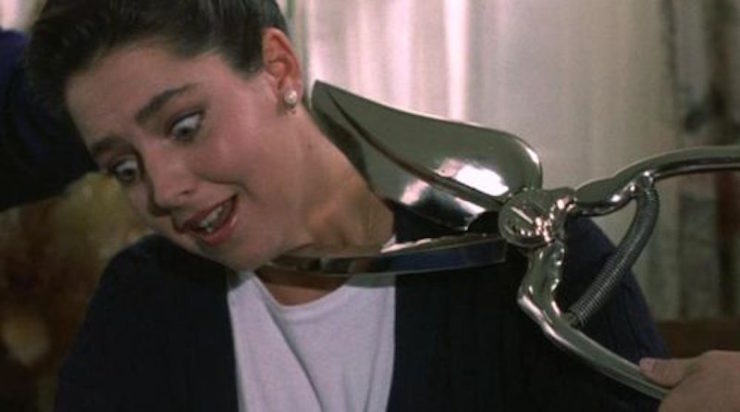
Even though the film doesn’t really deal with issues of sexuality or gender, the story still has to come down to a man defending a vulnerable young woman from demonic evil—this time a biological father rather than spiritual one.
Exorcist: The Beginning (2004) and Dominion (2005)
After Legion failed at the box office, Hollywood took a break from The Exorcist. It wasn’t until 2004 that a new film in the series was made, and things quickly went demonically pear-shaped. Paul Schrader, the writer of Taxi Driver and Raging Bull, and director of one of my all-time favorite movies, Mishima, wanted to make a somber meditation on morality and faith. And he decided that the way to do this would be to examine Father Lankester Merrin’s early years, and his decision to devote himself to exorcism. Once the studio saw that Schrader really meant the “somber” part, they opted instead to amp up the horror and make the exorcism more gruesome, making the bonkers decision to shelve Schrader’s version and hire Renny Harlin—director of the worst Die Hard movie—to reboot a film that hadn’t even been released yet.
But wait, it gets better.
They used the same script, sets, character names, and even a few of the same actors. Harlin’s version (Exorcist: The Beginning) was still a little somber, and had a few meditative conversations on faith and morality, but was also an over-the-top horror movie. But it still tanked at the box office, so then the studio slapped some garbage CGI onto Schrader’s version (Dominion: Prequel to The Exorcist) and released it nine months later. It also failed. Both films center on the excavation of an ancient church, a war between British soldiers and African villagers, and a small boy who may or may not be possessed.
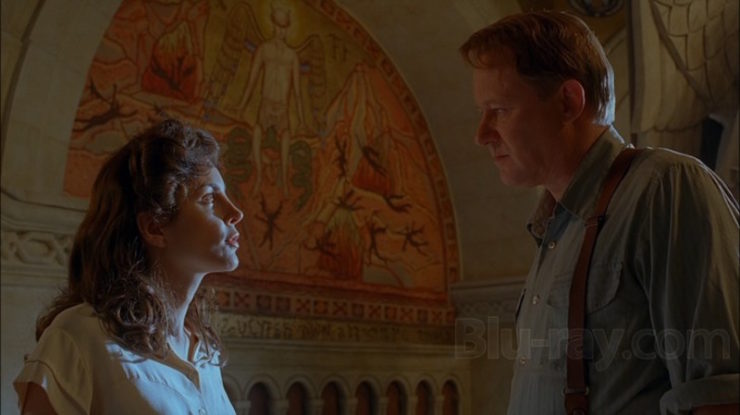
Please understand: neither of these films is good. Dominion has some good ideas, but it’s also listless, and the “exorcism” ends up being a battle of wills between Merrin and the demon. At one point the demon puts the village nurse, Rachel, into a trance, making her relive the Holocaust with the heartbreaking twist that she’s a hero this time, saving lives left and right. When Merrin wakes her out of the trance, she almost collapses under the weight of her true memories, which include trading sex for food in the camps. The distraught Rachel kisses Merrin, and says the two of them could escape and start over together—despite there being no flirtation between the two of them during the rest of the film. Rachel was a compelling character just as she was, but in one rushed, unnecessary scene, a character who has spent the whole movie selflessly healing villagers becomes a damaged woman who falls for a demonic trick and tries to tempt a priest away from his calling.
But that’s nothing compared to the Harlin version. In The Beginning, the village nurse is recast as a doctor named Sarah who dresses like a cross between Ilsa in Casablanca and Elsa in Last Crusade, and has perfect curls of blonde hair no matter how humid and sweaty the village becomes. She and Merrin immediately establish sexual tension, and where Schrader’s nurse urged Merrin to return to the church, Harlin’s flirts with him, and lies about the fate of her husband—she says he abandoned her after realizing she’s been raped by Nazis, but it turns out he was driven mad by a demon. In a staggeringly short amount of screentime, she fends off rape threats from a pilot covered in boils, she stars in a long shower sequence straight out of an ’80s slasher movie, and it’s revealed that she suffered through a forced hysterectomy at the hands of the Nazis.
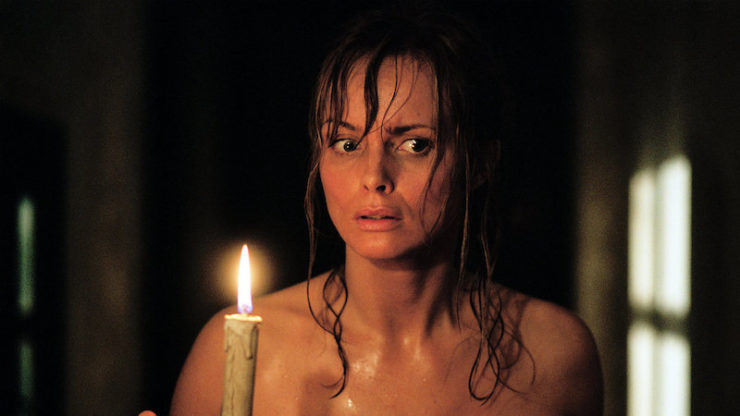
But all of this is merely a prelude to the plot twist that she is actually possessed, and has been lying to Merrin the entire time. Once she lures him into the bowels of the excavated church, she jumps on top of Stellan Skarsgard like Emily Watson’s Breaking the Waves understudy, and gets to say things like: “He [God] doesn’t care about this whore. But you do… because you want to shove your rotten cock up her juicy ass!” and “What’s the matter, Merrin? Don’t you wanna fuck me any more?”
Oh wait, she doesn’t say things like that, she says exactly that. This gives Merrin an excuse to throw her around a lot while exorcising her.
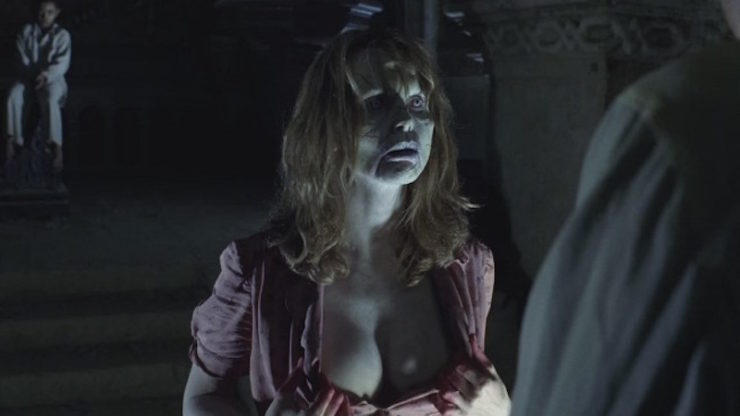
Once again a demon uses a female body as an instrument of rape, but this time, though the exorcism is successful, Merrin doesn’t manage to save the woman’s life. This is the priest’s tragic origin story. And thus endeth The Exorcist series, with Lankester Merrin walking out into the African savannah (Dominion) or the cobblestones of Rome (The Beginning), another battle with Pazuzu awaiting him in the future. A mysterious, badass character had been explained into a pulp.
The Exorcist (2016-present)
It seemed nothing more needed to be said, right? But when Jeremy Slater created a television series/sequel to expand the universe of The Exorcist films he took this crazy stew and created a show that not only does justice to the horror elements but also creates a meditation on faith and doubt that is stronger than the original film’s, and it does this while turning the story into a tale of heroic feminists and queer people.
Neat trick, right?
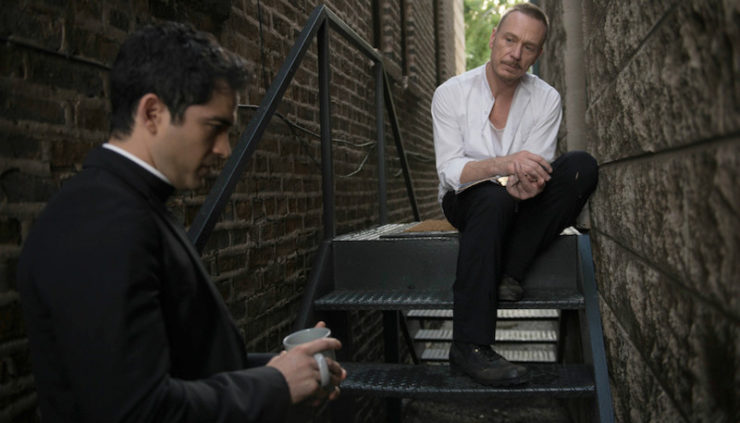
Dealing with matters of religion can get pretty emotional, so bear with me a minute. I would argue that one of the cruelest aspects of religious fundamentalism, and even some “mainstream” religion, is that is strips queer people of their faith. Unless your desires and loves fall exactly within heteronormative childbearing parameters, in many religions, you’re considered wrong. Sinful. Damned. And so generation after generation of young queer kids hits a certain age and finds that they have to choose between their love of God and their desire for human love. Depending on your faith community, you may find yourself having to choose between your home—both literal and spiritual, and your self. This tension threads through the Catholic Church’s stance on gay priests, the conflation of pedophilia and homosexuality, arguments between Anglicans and Episcopalians over who gets to be a priest and/or a bishop, Orthodox and Conservative Jewish communities shunning gay members, “gay therapy” electric shock and torture, pray-the-gay-away camps… And that’s all besides any interpersonal issues, like fag jokes, gay-bashing, queer kids having to confess things about their sexuality to priests who might think they’re even more sinful than their straight peers, queer kids thinking the God they love actually hates them… it all gets pretty fraught, pretty fast, and leads to a lot of violence and pain. I would hope that anyone reading this can understand the horrifying schism this causes, whether or not they’ve experienced it.
The reason I bring up this fairly personal, emotionally explosive stuff, is that The Exorcist TV series takes all of that and throws it all away, and it does this as a direct rebuke to the entire film series before it.
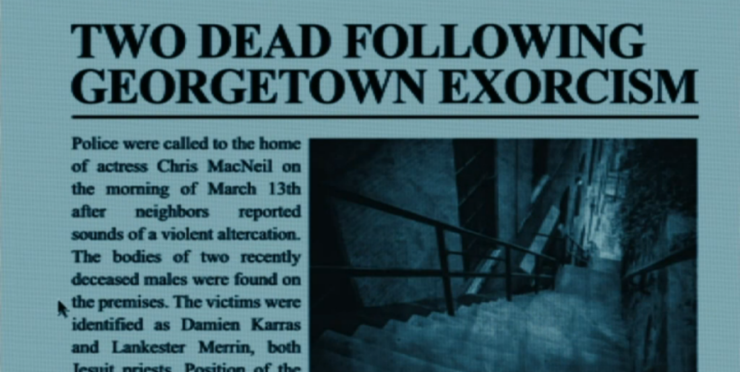
The show follows two priests, renegade Irish English priest/traveling exorcist Father Marcus, and proper, community-building Mexican-American parish priest Father Tomas. In Season One the two of them team up to save the Rance family, who are under attack by seemingly the same demon who possessed Regan MacNeil in the 1970s. The show is set in the current day, and the exorcism in Georgetown is part of the show’s canon: Father Tomas reads articles about it to prepare himself for the Rance exorcism.
The Rances, meanwhile, are not quite what they seem. When we meet them, Angela Rance is a go-getting career woman who also seems to be a devoted mother—a stark contrast to Chris MacNeil’s hands-off parenting style. The other obvious difference is that she’s an avid churchgoer, and her family is an active part of their local Catholic parish. Angela is caring for her husband Henry, who has suffered a head injury that’s led to lasting brain trauma. Her two daughters, Kat and Casey, each have issues: Kat was just in a car accident that killed her best friend and probably ended her promising dance career; Casey seems a bit depressed and bratty from being put on the backburner while the family deals with these bigger tragedies.

So far so good, but here’s where things get more interesting. Angela wants an exorcism of Kat because she thinks she might be possessed. She claims to “know depression,” and says this is something worse. She’s wrong about the possession (it’s Casey who’s possessed, but more on that in a second) but she’s also right: Kat is depressed because she and her best friend were finally admitting they were in love with each other—they were just about to kiss when they crashed. And in the midst of a traditional horror show, The Exorcist gives us a gentle, season-long exploration of grief as Kat mourned her friend and the love they might have shared. The show always, always, always treats this relationship with respect. It’s not titillating, it’s not shot for the male gaze. The two young women cared deeply for each other, and there is every indication that the show takes their love seriously. This is especially important because…
Father Tomas has an affair with a woman, and it’s a problem! Not because sex is bad in the show’s universe (it’s not) but because he’s breaking his priestly vows, and his friend, Jessica, is breaking her marriage vows, and they both have to lie a whole bunch to keep the relationship rolling. This compromises Tomas, opening him up to a particular type of demonic attack during the exorcism, which in turn endangers Casey’s life. Things get so bad that Marcus has to throw Tomas out of Casey’s room, just as Merrin had to kick Karras out of Regan’s forty years earlier. Tomas has to break things off with Jessica, endure public humiliation when her husband confronts him, and, finally, repeatedly confess and ask for forgiveness, before he can finally come back at the end of the season to assist with the exorcism. The show takes us the time to show us the real consequences of his actions, but more importantly: this is a show in which the burgeoning queer relationship is loving and healthy, but the heterosexual affair is a problem. This is extra-wonderful because…
Marcus’ sexuality is never an issue. The demon tries to taunt him with sexual remarks about Casey at one point, but then backtracks, saying “girls were never your flavor, were they?” and we gradually learn that Marcus is gay, open about it, but doesn’t act on it because of his commitment to the priesthood. It’s not something the demon can use against him because it isn’t a problem. He’s also never coded as a gay stereotype with swanky parties and showtunes, the way Father Dyer was in the original film—Marcus is a badass priest, a professional exorcist in a world where demons are real, and he’s willing to fight them, or humans, with equal panache. We only receive a matter-of-fact confirmation that he’s attracted to men in the final episode of the season—because his sexuality is only part of his personality, not his defining characteristic.
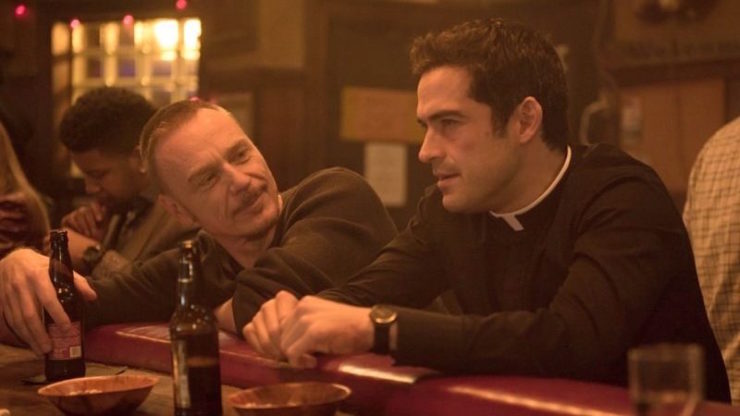
By the end of Season One Marcus has been excommunicated, and here’s where the show makes two choices that are unlike anything I’ve seen on TV recently: Marcus is captured and tortured by demon-worshippers. Despite his excommunication, he refuses to give in—his faith in God is strong enough that while he certainly doesn’t want to be tortured, he also doesn’t fear death. His faith is part of him, and is not determined by his standing in the church, or the fact that he’s attracted to guys. As we see in the scene right before he faces his torturers, he almost hooks up with a guy at a bar. The scene is presented completely casually, because unlike Tomas, he doesn’t have vows to uphold, and unlike Kat, this isn’t a first love/coming out moment. It’s shot like any other scene of two attractive strangers making eye contact across a bar, and the weight of the scene only comes from the spark of attraction between the two men (and the idea that it’s probably been a while for Marcus, since he became a priest pretty young) but then that spark is snuffed because Marcus has to bolt off to rescue the Pope.
It’s an action-packed show.
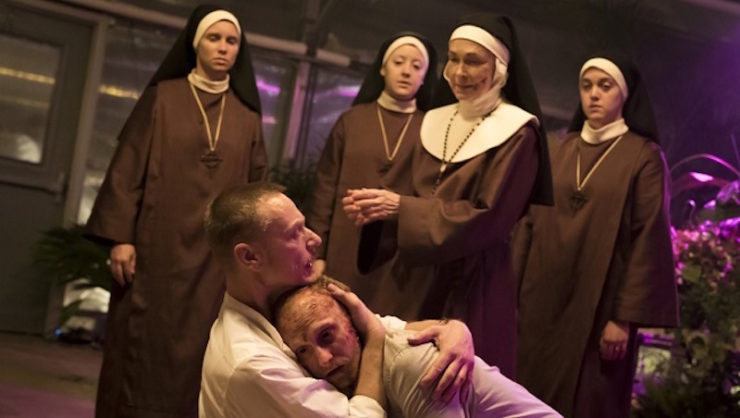
We also get an extraordinary subplot in which a group of nuns are revealed to practice their own type of gentle, healing exorcism, in which the possessed person is strengthened through a loving ritual conducted entirely by women. When Marcus encounters this group, it seems at first that he’s going to mock them, reject their methods, and move on, but instead the show gives us multiple instances of him learning their techniques. In the end, he makes a point of using some of their prayers when working with Casey. This marks the first time in the franchise that women have been anything other than victims or bystanders, as well as the first time we see the power of nuns compel anyone to do anything. As with the show’s steady development of Kat’s character, it’s another instance of the show giving real weight and focus to a story about women.
Now, about that pesky possession:
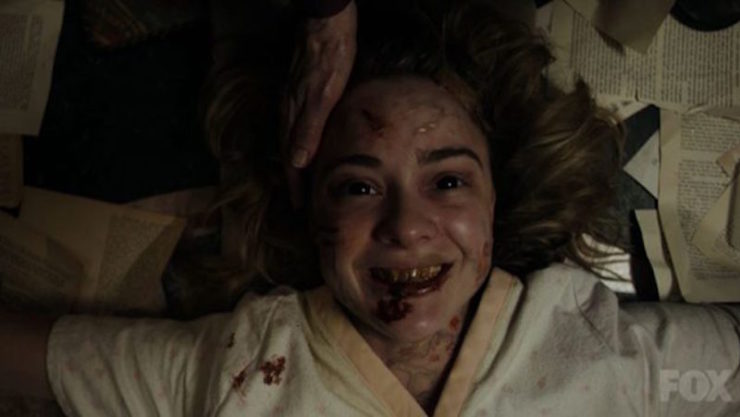
Unlike in any of the previous iterations of The Exorcist, Casey interacts with the demon on screen, who calls himself Captain Howdy. He sits next to her at dinner, talks to her on the family’s stoop, tells her she’s beautiful, helps her shop. At first it seems like a barely-teenage girl is creating an imaginary friend, a fairly normal psychological trick for a kid dealing with the near death of both her dad and her sister. This is one of the best elements of the show—by taking us inside the possession, it gives us the possessed person’s perspective of being possessed. Rather than seeing a tortured, objectified little girl’s body, we see Casey inside her own mind, being seduced by a voice that seems to love her, care about her, and see her, the way her family is supposed to, the way her church tells her God is supposed to. But where she feels abandoned by her family, and probably blames God for her dad and sister’s accidents, Captain Howdy accepts her and supports her. As the possession gets more serious, she argues with the demon and tries to physically fight it. We also see the demon’s attacks from her perspective, so we get a better sense of the stakes as she realizes she can’t get rid of him. In short, the show grants Casey an agency Regan was never allowed to have in the films.
This is expressed in the exorcism itself as well. The show touches on some of the aspects of the original Exorcist. Where Regan was raped with a crucifix, Casey burns herself with a curling iron while Captain Howdy watches with sadistic glee, and seems to enjoy the pain as much as she hates it. Where Regan urinated on the living room floor to disrupt one of her mother’s parties, Casey pisses on an El train—but in a far different context. A group of men harass Casey, groping her in front of her father, and she uses a surge of demonic strength to fight the guys off, beat one of them to a pulp, and defend her dad. Only then, as Captain Howdy leaves her, does she sag and pee everywhere. In both cases there’s a really interesting push and pull between Casey wanting the power that her possession gives her, and even reveling in some aspects of the pain she’s inflicting on herself and others, and wanting desperately to be free of Howdy.
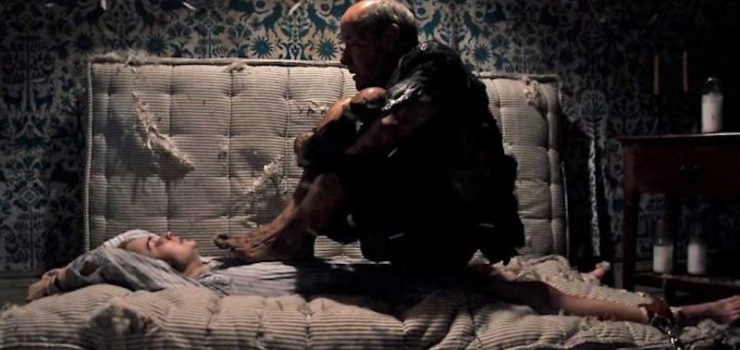
But Casey’s possession is really just an amuse bouche for the show’s real, fascinating twist. Her mom, Angela Rance, isn’t really Angela Rance—she’s Regan MacNeil! She changed her name, doctored her past, married Henry Rance, and cut off all ties to her mother, after she exploited the exorcism in Georgetown with a tell-all book. Chris only did this to support Regan after her acting career tanked, but Regan/Angela has never fully forgiven her. Chris shows up toward the end of the season (in a fabulous call-back the classic Exorcist poster) which forces Angela to tell her family the truth, and try to reconcile with her mother. This is all folded into the show as a better resolution to Regan’s arc than Heretic gave us, but then the show twists it again.
During the last moment’s of Casey’s possession, Pazuzu grins at Angela, grabs Casey’s neck, says “Time to give the people what they want” and prepares to twist it, which will obviously kill her. Angela recognizes what’s about to happen and begs the demon to take her instead. Which means she invites him in, giving him even more power than he had the last time. Externally, we see him use this power to murder her mother, pushing her down the stairs of Angela’s family home in a sick reboot of the deaths of Burke Dennings and Father Karras. Internally, this allows the show to take us into Angela’s mind, essentially re-telling The Exorcist from Regan’s perspective. We see her playing with the Ouija board. We see how kind and funny Captain Howdy was, once upon a time.
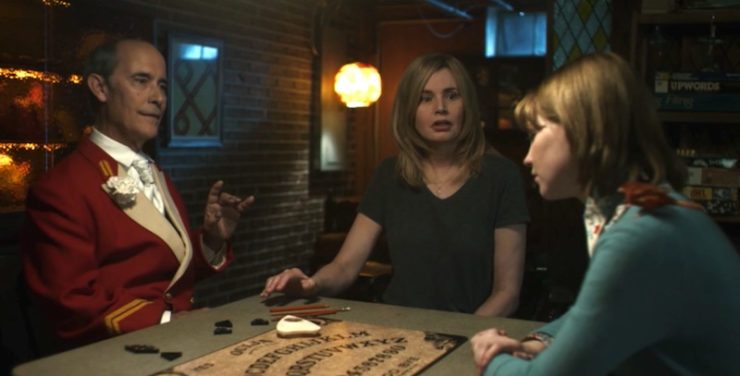
In all the Exorcist movies, we observed possession from the outside: the gore, the swearing, the pain, all from the perspectives of Karras and Merrin and their celibate helper priests. We are meant to empathize with the heroic, emotionally conflicted men, while we pity the poor tortured women and children. But in the show, we get to see the manipulation the demon is capable of.
As in Heretic, Regan/Angela is split in two by the possession. There’s delightfully evil Demon Angela (who allows Geena Davis to do some fantastic scenery-chewing as she tortures her family and Father Tomas) and there’s terrified, exhausted Angela, trapped in a tiny corner of her own mind. She’s in a replica of her old Georgetown bedroom, sleeping in the bed that hosted her first exorcism. Meanwhile, Tomas is likewise trapped in his mind when he attempts an exorcism. Pazuzu banishes him to a reconstruction of his old Mexico City apartment, where he will have to watch his grandmother die while a demonic version of Marcus taunts him. Hope seems lost, Demonic Angela begins torturing the family, and we wait for Marcus, the only other priest, to show up and save the day.

But instead of Marcus riding in with the theological cavalry it’s Casey, the terrified, victimized teenage girl, who steps up. First she pleads with her mother to hear her and fight Pazuzu, waking Human Angela. Human Angela realizes that Captain Howdy is just outside the door, telling her that she doesn’t get to say no or push him away—the only way she can end her family’s suffering is by opening the door. Meanwhile, in Tomas’ head, Demonic Marcus is encouraging Tomas to use the butcher knife that’s suddenly appeared in his hand and kill himself. In the waking world, the entranced Tomas presses a knife to his throat. Again, it’s Casey who gets through to him. Her voice echoes in the apartment, and he drops the knife in the vision and in the waking world, and comes back to himself just in time to rescue Casey from the enraged Demonic Angela. As Tomas begins another exorcism, Casey refuses to abandon her mother, instead taking on the Assistant Exorcist role as Karras and Tomas each did before her, and Henry and Kat decide to come back. It’s their voices that Human Angela hears, and here is where the series truly engages with its past. As Tomas continues the exorcism in the waking world, Angela faces Captain Howdy at last, invites him in to that last corner of her mind, and stomps him. Finally, after forty years, we get grown-up Regan fighting the demon, strengthened by her daughters’ love. We see her fighting for herself and her family now, avenging the murder of her mother, and fighting against the demon that has plagued her whole life. She is the one who defeats the demon, not Tomas or Marcus.
The ending of Season One brings the story of The Exorcist full circle—from a little girl attacked by forces beyond her comprehension to a grown woman and her young daughters defeating those forces together. In the last scene of The Exorcist, Regan claimed not to remember her possession, but then kisses Father Dyer, in a clear indication that she remembers that a man in a white collar saved her life. Here, Casey and Marcus sit together for an entire scene, discussing what happened to her. She is grateful, but she’s also a real human, not just a chastened girl who has been rescued. She has thoughts and opinions about what happened to her, and the de-frocked Marcus is happy to sit and listen to her as a friend rather than an authority figure. Instead of a cute kiss on a collar, the Rance exorcism ends with Marcus and Casey sitting together, talking about what’s happened as equals. Marcus assures her that this wasn’t her fault, and tells her that in his 40 years of being an exorcist: “You might be the strongest person I’ve met in my whole life.”
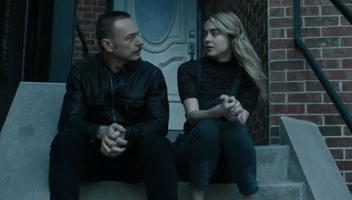
The strength of the new iteration of The Exorcist lies precisely in its choice to confront the underlying guilt of the first film that James Baldwin diagnosed in his essay “Where The Grapes of Wrath Are Stored” in his seminal book of essays, The Devil Finds Work. In the essay he considers the film, and argues that the true cause of the problems is both the guilt Chris MacNeil feels due to her “liberation”, and the guilt Karras feels about his mother. But he points out, along with some digs at the film, that it never truly confronts that guilt. Karras dies, possibly damned (I would argue against that), and Regan forgets what happens to her but retains an affection for white collars. Baldwin’s take is that all the effects can’t hide the fact that Satan is us. Satan is the complicit bit behind your eyes that buys into middle class life at the expense of other people’s suffering, that buys into white supremacy, buys into capitalism, buys into a milquetoast, white-written version of history.
For, I have seen the devil, by day and by night, and have seen him in you and in me: in the eyes of the cop and the sheriff and the deputy, the landlord, the housewife, the football player: in the eyes of some governors, presidents, wardens, in the eyes of some orphans, and in the eyes of my father, and in my mirror. It is that moment when no other human being is real for you, nor are you real for yourself. The devil has no need of any dogma—though he can use them all—nor does he need any historical justification, history being so largely his invention. He does not levitate beds, or fool around with little girls: we do.
This is a vital read on the film—where the middle-class values are affirmed and reinforced by celibate white men who swoop in to fix a mess the women had made through their emancipation and dabbling in occultism. And what I think the television version of The Exorcist has somehow, improbably, done, is begin the work of calling the franchise on its own complacency. Here, in a retelling of a story that seemed well past its prime, we get a pair of priests who live in both the world of Catholic male authority, but also as a Mexican-American immigrant and also as a gay man, both from impoverished backgrounds, who actively challenge Church hierarchy and subvert it from within. Rather than the male authority figures restoring “normalcy” after a grotesque, sexual upheaval, we get multiple groups of women who fight back against demons, who take their rescues into their own hands. Rather than a parade of conflicted priests, we get Marcus, who keeps his faith on his own terms. And now, a few episodes into Season Two, I’m excited to say that the show has continued its commitment to the kind of casual diversity that reflect life in America, it’s continued being respectful to both the religious and the secular, and it’s continued balancing fantastic, three-dimensional characters with genuine scares.
Leah Schnelbach is pretty sure she could exorcise a demon after all the time she’s spent on this article. The power of Twitter compels you to, um, Tweet! Y’know, if you want to.










